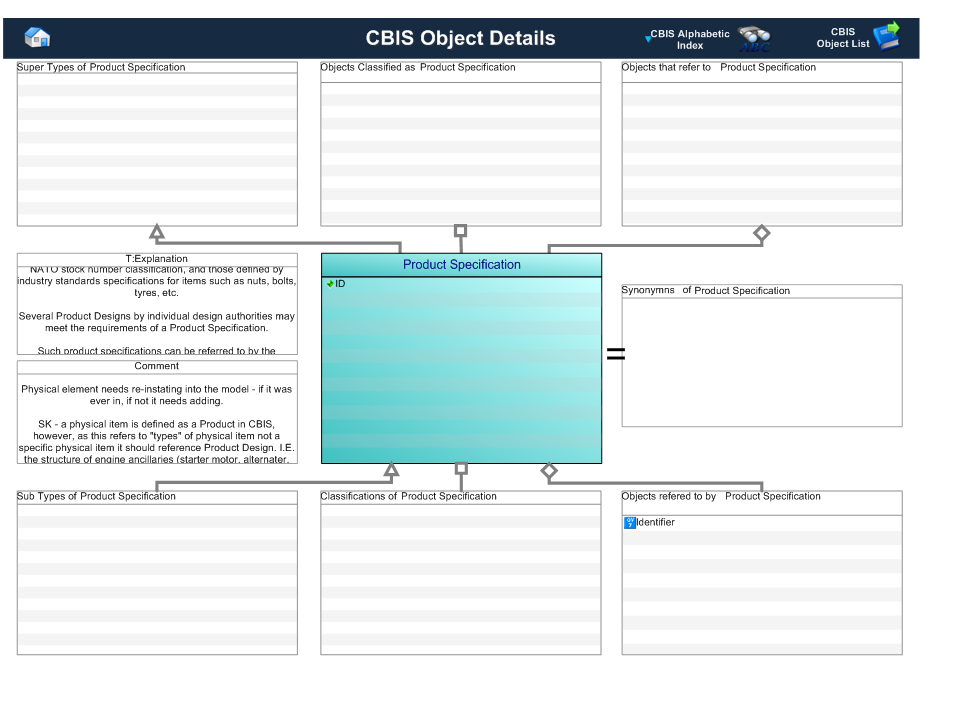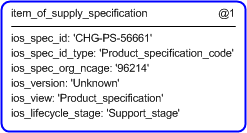Template:— product_specification (prod_spec)
Context:— UK_Defence |
Date: 2009/04/17 11:04:01
Revision: 1.3
|
This section specifies the template product_specification.
NOTE
The template has been defined in the context of
UK_Defence.
Refer to the business context for details of related templates.
NOTE
An explanation of a template and the associated instantiation path is
provided in the
Template overview
section.
This template describes how to represent the UK_Defence concept of a product specification
in terms of PLCS model elements (templates, entities, and reference data).
This information object represents the specification of a type of product in terms of its functional and/or physical characteristics.
A product specification does not contain the level of detail neccessary in order to manufacture and / or assemble a product
that meets the specification. That level of detail is only provided by a product design.
Typical Product Specifications are those defined by each NATO stock number classification, and those defined by industry standards
specifications for items such as nuts, bolts, tyres, etc.
Several Product Designs by individual design authorities may meet the requirements of a Product Specification.
Such product specifications can be referred to by the elements of a Product Design as well as/instead of an individual Product
Design, depending on the item in question.
NOTE: The characteristics that define a Product Specification are defined by the Property information object.
NOTE: The document(s) that define a Product Specification are defined by the Document Association information object.
This information object represents the information about a Product Specification.
Figure 1 — A MOOD Business Architect representation of the Business Object: Product Specification
The attributes of the Product Specification object are tabled below.
|
Attribute name
|
Attribute description
|
Attribute type
|
Optionality
|
| ID |
The ID is the identification given to the Specification. |
Identifier |
Mandatory |
| Identifier.id |
This is the value of the id attribute of the Identifier applied to the Product Specification. |
intrinsic |
Mandatory |
| Identifier.type |
This attribute is the type associated with the id of the Identifier given to the Product Specification. This must be one of
the classes provided.
|
Product_specification_code |
Mandatory |
| Identifier.source_organization |
This attribute is the value representing the source organization that provides the id of the Identifier given to the Product
Specification. This value is assumed to be an NCAGE_code.
|
intrinsic |
Mandatory |
Table 1 — Product attribute details
The EXPRESS-G diagram in
Figure
2
shows the templates and EXPRESS entities that are required
to represent the template
"product_specification".
The text highlighted in blue shows the template parameters.
Product Specification constrains the id, view and context parameters to be of a certain type. The id type maybe specialized
further as required. The lifecycle parameter is defaulted to the support stage, and the view to be of type Product Specification.
Figure 2 — An EXPRESS-G representation of the Information model for product_specification
The graphic for the template to be used in other EXPRESS-G diagrams
is shown in Figure
3
below.
Note - although no version is required or provided for in the business object, the PLCS representation requires one - this
is made available as a reference parameter. The value is defaulted to 'unknown'.
Figure 3 — The graphical representation of the product_specification template
The following input parameters are defined for this template:
spec_id_type (Default=Product_specification_code,Type='CLASS')
The type of identifier for the specification - is assumed to be Product_specification_code
The following classes and their sub-classes can be used:
classifications: [Product_specification_code]![[warning:]](../../../../../../images/dex/warning.gif) Error RDL4: The URI urn:plcs:rdl:uk_defence is not listed in dexlib/data/refdata/rdl_index.xml
Error RDL4: The URI urn:plcs:rdl:uk_defence is not listed in dexlib/data/refdata/rdl_index.xml
The ncage identifier of the organization (assumed to be a design authority) that provides/owns the specification
The following reference parameters are defined for this template:
Allow the
Part
entity instantiated in this path to be referenced when this template is used.
Note: The
Part
entity can be referenced in a template path by:
%^target = $product_specification.specification%
where
target
is the parameter to which the
Part
is bound.
Allow the
Part_version
entity instantiated in this path to be referenced when this template is used.
Note: The
Part_version
entity can be referenced in a template path by:
%^target = $product_specification.specification_version%
where
target
is the parameter to which the
Part_version
is bound.
Allow the
Part_view_definition
entity instantiated in this path to be referenced when this template is used.
%^target = $product_specification.specification_view%
%^target = $product_specification.specification_contxt%
The instantiation path shown below specifies the entities that are to be
instantiated by the template.
A description of templates and the syntax for the instantiation path is
provided in the
Templates Help/Information section.
/
item_of_supply_specification(
ios_spec_id=@spec_id,
ios_spec_id_type=@spec_id_type,
ios_spec_org_ncage=@spec_org_ncage,
ios_view='Product_specification',
ios_lifecycle_stage='Support_stage')/
-- re-direct the output from the call.. %^specification = $item_of_supply_specification.ios_specification%
%^specification_version = $item_of_supply_specification.ios_spec_version%
%^specification_view = $item_of_supply_specification.ios_spec_view%
%^specification_contxt = $item_of_supply_specification.ios_spec_contxt%
The instance diagram in Figure
4
shows an example of the EXPRESS entities and templates that are instantiated by the template:
/product_specification(spec_id='CHG-PS-56661', spec_id_type='Product_specification_code', spec_org_ncage='96214')/
(an illustration of the consolidated product_specification template is shown in
Figure
5 below.)
Figure 4 — Entities instantiated by product_specification template
The instance diagram in
Figure
5
shows the graphic symbol for the template that is to be
used in other instance diagrams. The example template is:
/product_specification(spec_id='CHG-PS-56661', spec_id_type='Product_specification_code', spec_org_ncage='96214')/
Figure 5 — Instantiation of product_specification template
The following section details how the
product_specification
template can be optionally characterized by assigning
other constructs to it. These are characterizations commonly
applied to the template. The ISO 10303-239 EXPRESS model may enable
other assignments to the entities instantiated by the template.
The EXPRESS-G diagram in Figure
6
shows the possible characterizations of the template
"product_specification".
Figure 6 — Characterizations for product_specification
The following characterizations may apply:
Characterization NSN
NOTE this characterization is optional.
A UK_Defence.product_specification
may have a Nato Stock Number assigned to it, through the use of the following template:
representing_resource_item_realization.
The following template calls show how this characterization
might be instantiated.
/representing_resource_item_realization(res_item_id='5905-00-7345199', res_item_id_class='NSN_code', res_item_id_ecl_id='urn:plcs:rdl:std', res_item_id_org_id='96412', res_item_id_org_id_class='NCAGE_code', res_item_id_org_id_ecl_id='urn:plcs:rdl:std', res_item_items='@product_specification')/





